Oil Leaks When Car Is Parked: 8 Causes
A damaged oil pan seal or drain plug is the most common reason that oil leaks when a car is parked or off. Oil can also leak from other places if the car sits at an angle too long. These places are the oil pressure sending unit, oil pump o-ring, oil filter seal, or engine seals and gaskets. Parking uphill raises the chance of oil leaks happening. Clogged PCV valves cause high pressure inside the engine. This pressure can push oil past seals. Regularly checking seals and gaskets can prevent leaks.
Oil leaks when parked are a headache. It’s hard to see where oil leaks come from when not driving. But don’t stress. With some effort, you can find the leak source and fix it. Read this guide till the end as I will uncover some of the most common causes of oil leaking when car is parked.
I’ve developed an interactive tool for you all to troubleshoot car issues. It guides you through easy steps to identify the problem. Don’t forget to try it.
Bonus Read: 5.3L engine common oil leaks
- Oil leaks when parked can come from many places – oil pan, drain plug, oil filter, seals, sensors, valve covers. Regular inspection helps catch issues.
- Engine heat when running causes gaskets and seals to expand, reducing leaks. When parked and cooled, leaks can occur more easily.
- Oil leaks often start small but can become serious if ignored. Identify the exact source of leaks by thorough cleaning and using talcum powder or UV dye.
- With high mileage engines, upgraded viscosity oil can help reduce leakage through increased clearances.
What is My Personal Experience With Oil Leaking When Car Is Parked?
Once my coworker John came to me concerned about an oil leak on his 2015 Toyota Camry. He showed me the small puddle forming on his garage floor whenever the car was parked.
I had him pop the hood so I could inspect the engine. I noticed oil dripping from the valve cover and suspected the gasket was worn. I confirmed this by removing the cover and seeing the old brittle gasket.
I advised John to replace it with a Toyota OEM gasket set. He ordered the parts and I walked him through the replacement process – cleaning the surfaces, applying sealant, torquing bolts to spec. The repair only took an hour and completely fixed his leak.
Can You Drive With An Oil Leak?
Yes, you can drive with an oil leak. Whether you can keep driving with an oil leak depends on a couple of key things. Let’s walk through checking them.
First up, take a peek at the dipstick to see if the oil level is between the full and add marks. Too little oil can badly hurt the engine.
Next, check the oil pressure gauge on the dashboard. The needle should point to the pressure range listed in your owner’s manual. Low pressure signals that the engine won’t get enough lubrication. That lack of lubrication can ruin the bearings that let the crankshaft spin smoothly.
If the oil amount or pressure is too low, do not keep driving with the leak. Oil is vital – it keeps all the engine parts slick and running properly. Without enough oil and pressure, the engine can overheat, freeze up, and sustain damage.
To learn more, you can read my guide about what happens if you don’t change oil for 2 years.
How to Perform Visual Inspection Of Oil Leak?
Before you investigate the reasons behind an oil leak when the car is parked, you should first confirm that it is actually engine oil and not something else. Oftentimes, people mistake engine oil, transmission oil, and coolant.
So, if the color of liquid leaking from car when parked is:
- Brown or black: It indicates engine oil.
- Blue, orange or green: It indicates coolant.
- Reddish or red-brown: It indicates transmission oil.
- A very light pale or Golden color: It usually represents brake oil oil power steering fluid
- Golden color: It represents power steering fluid. It also gets dark brown/black with time.
What are the Causes of Oil Leakage When Car is Stationary?
Here are the causes of oil seepage from parked vehicle:
1. Gasket Of Oil Pan Is Damaged
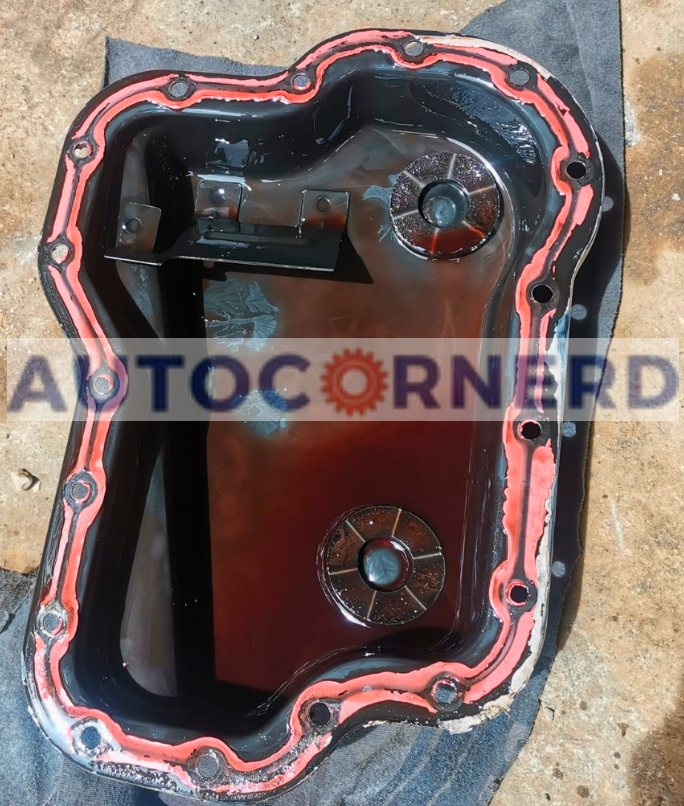
The oil pan is at the bottom of the engine. All the oil runs down into it when the engine isn’t running.
The oil pan gasket is a thick rubber seal. It sits between the oil pan and engine block. Its job is to prevent oil leaks from the oil pan.
Over time, the gasket can get old and start breaking down. This happens because of the engine’s heat and pressure.
When this happens, oil can start leaking from the pan when your car is parked. The oil will drip onto the ground under your car.
How can damage to the oil pan gasket cause an oil leak?
The rubber gasket can get damaged for a few reasons:
- Rough roads: Driving on bumpy roads can make the oil pan shake around. This can wear down or damage the gasket.
- Debris: Dirt and debris can get into the oil pan and hurt the gasket.
- Age: Over time, the gasket just gets old and brittle.
The oil pan is at the bottom. So a leak from higher up will hit the seam between the pan and engine block. Then it will go all around, making it look like the gasket is leaking.
How to fix leaking oil pan gasket?
Always use an OEM-recommended oil pan gasket. Don’t go for cheap aftermarket alternatives.
To install a new oil pan gasket, use the engine degreaser to clean the mating surface of the oil pan, and remove foreign particles, such as RTV, dirt, and oil. If the mating surface of the oil pan is not cleaned properly, it will not seal the gasket.
I would recommend this engine degreaser to clean the mating surface of the oil pan. Use a lint-free towel to clean the mating surface of the oil pan before installing the gasket.
If the oil pan is chrome-plated, brush out the drain hole threads to clean any leftover flakes that could start a leak. You may also need to tap around the bolt holes of the oil pan.
After cleaning the oil pan mating surface, apply a thin bead of RTV silicon sealant to adhere the new oil pan gasket to the oil pan. Make sure that you don’t apply too much sealant. Mount the gasket to the oil pan. Allow some time for the adhesive to set. Test for slippage with light pressure. If the gasket moves, allow more time.
2. Warped Mating Surface Of Oil Pan
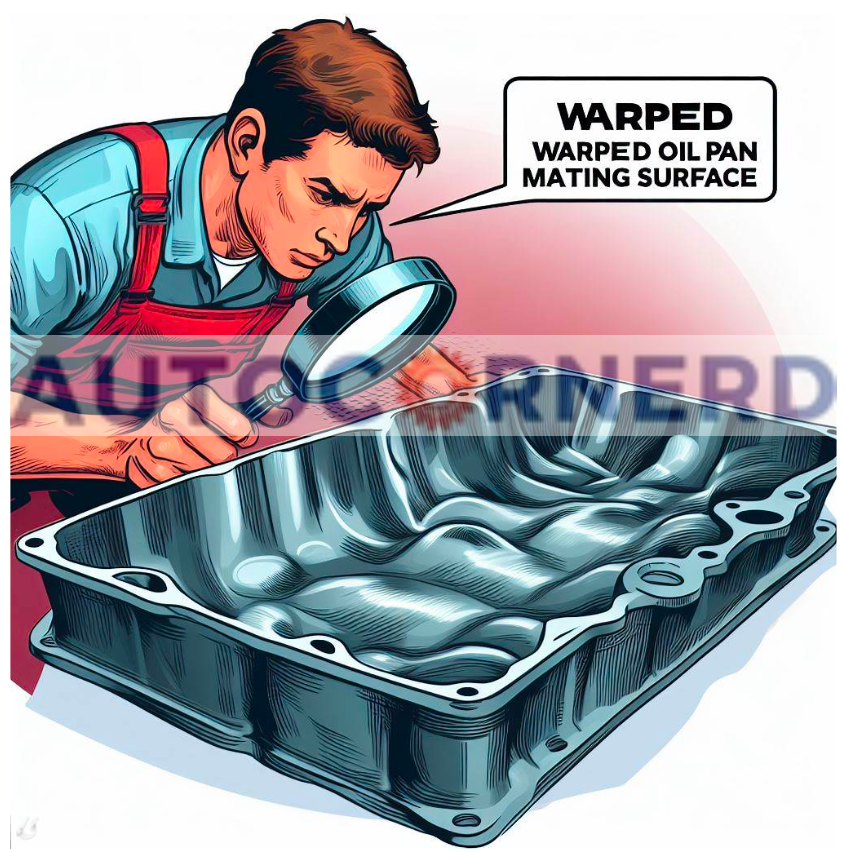
In addition to the oil pan gasket, you should check the bolts and mating surface of the oil pan if the oil leaks when your car is at rest.
The mating surface of the oil pan is the area that fits against the engine block. If this surface gets warped or cracked, it can no longer make a good seal with the engine block. Then oil can leak out.
Also, the bolts of the oil pan can get damaged from corrosion. This happens when metal of the oil pan is exposed to moisture, either from rain or condensation.
The moisture will cause the metal to rust and weaken. This leads to cracks or holes in the oil pan. In some cases, it can make the bolts come loose too.
Another possible way the oil pan gets damaged is from poor installation. If the oil pan isn’t tightly fastened to the engine block, it can make the bolts and mating surface become loose over time. This can lead to leaks, as oil will start to leak out from gaps in the mating surface.
How to diagnose warped oil pan?
If the mating surface of an oil pan is warped, it can be checked with a straight edge. Lay the straightedge lengthways along the flange that contacts the engine block.
Then take a feeler gauge and see if you can get any feeler gauge to slide in any spots under the straight edge.
Make sure that the gap between the straightedge and the oil pan is not greater than 0.1mm. If you find it warped, you’ll have to bend, pound, or hammer the oil pan till it’s straight again.
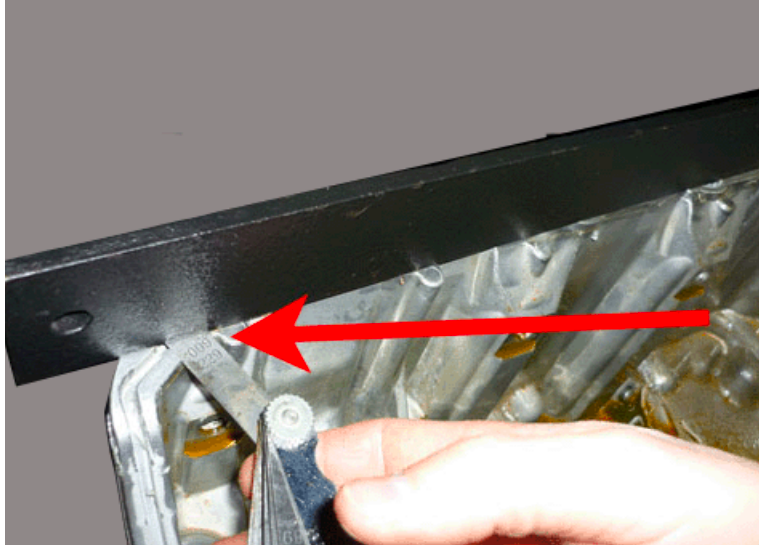
Lastly, when tightening the bolts, you should follow the torque specifications by the manufacturer. Avoid overtightening the bolts.
3. Loose Drain Plug Of Oil Pan
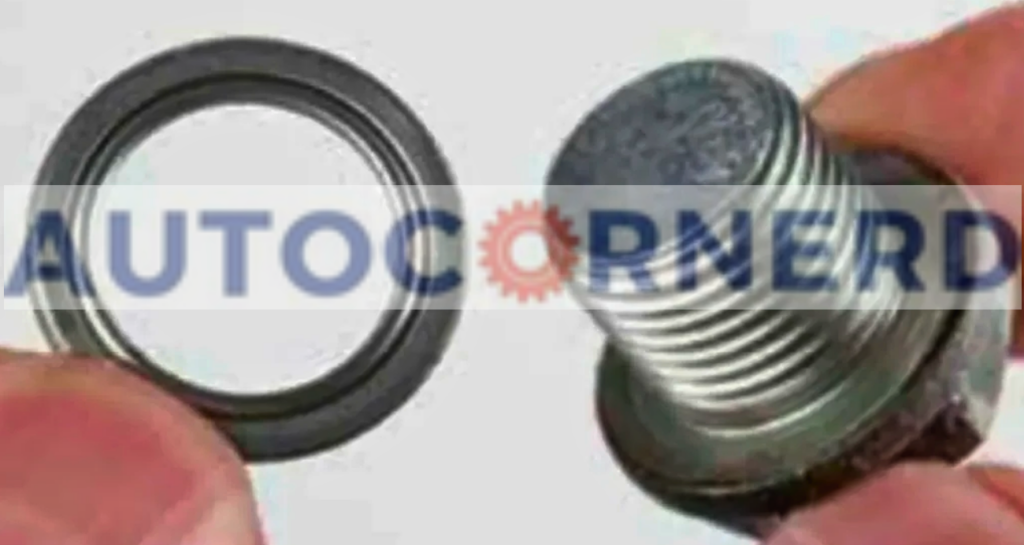
The drain plug screws into the oil pan. When you tighten it, the plug seals the pan. This stops oil leaks.
If the drain plug gets loose, oil can drip out. When your car is parked, oil may slowly leak. It makes a small puddle under the engine.
Luckily, fixing a loose drain plug is easy. I always replace the drain plug’s washer when I drain old oil. The seal gets damaged from sludge.
The metal plug usually has a metal washer, not rubber. So good seals are hard to find.
Use a torque wrench to tighten the plug. Follow the specs for your car model.
4. Oil Filter Is Loosen Or Misaligned
If the oil filter is not properly tightened or misaligned, it can lead to oil leaks when the car is at standstill. An oil filter is a very messy area of oil leakage. If it is ignored, oil can eventually get on the serpentine belt system and deteriorate the belt.
When the oil filter is loose, a gap is created between the oil filter and the engine. This gap will allow oil to bypass the filter and leak out. This is because the oil pump sends oil through the oil filter to the engine. If an oil filter is loose, the oil pressure can push the filter off, causing oil to leak out of the opening.
The configuration of the oil filter fitting depends on the type of engine. In some engines, an oil filter is fitted into the engine block through an adapter. In other engines, the oil filter is directly bolted into the engine block.
I have shown both configurations of the oil filter in the picture below:
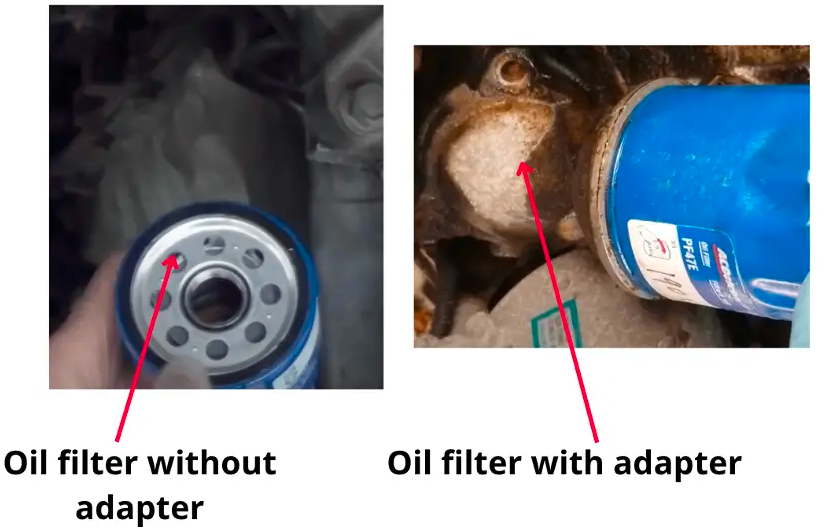
Furthermore, if an oil filter is not the OEM and the correct size, the pressure of the oil may be too strong for the filter, causing it to break or become loose.
Aftermarket oil filter of different size will be misaligned and slightly off-center from where it is supposed to be.
This will cause oil to leak out of the filter, making a mess and potentially damaging the engine if oil levels get too low.
Furthermore, while replacing the oil filter, most people forget to remove the old gasket that usually sticks to the engine block.
If you accidentally use two gaskets while installing the oil filter, they will blow out due to excessive pressure and cause oil leakage when a car is stationary.
So, you’ve to make sure that there is only one gasket of the oil filter while installing it. You should remove the old gasket.
You can check out the below video from 5:00 time. That guy has explained in detail about the leakages through the oil filter.
5. Valve Cover Gasket Is Damaged
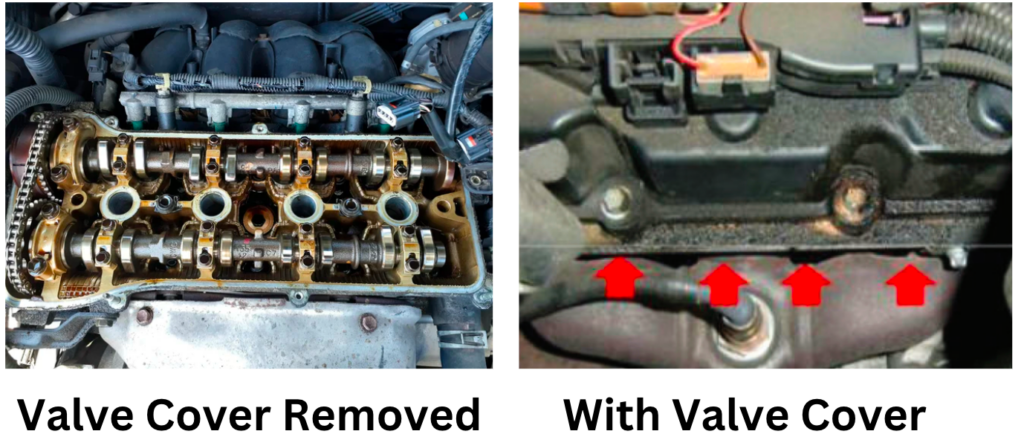
The valve cover gasket is an important seal in your car’s engine. It goes between the valve cover and cylinder head. The valve cover is also called a rocker cover.
The gasket stops oil from leaking out of the engine. Oil is needed to lubricate the camshafts. The camshafts open and close the valves. The valves let fuel and air in and out of the engine.
When the valve cover gasket is good, the valve cover stays on tight. No oil leaks out. But over time, the gasket can get damaged. Heat makes the gasket brittle. It can crack or tear.
When the valve cover gasket is bad, oil can drip out slowly. You might see oil on the ground under your parked car. That’s a sign the valve cover gasket needs to be replaced.
Some engines have plastic valve covers. Plastic can crack from heat in the engine. Cracks mean oil leaks too. If the valve cover is cracked, the gasket needs to be replaced.
6. Damaged Seal Of Crankshaft and Camshaft Position Sensors
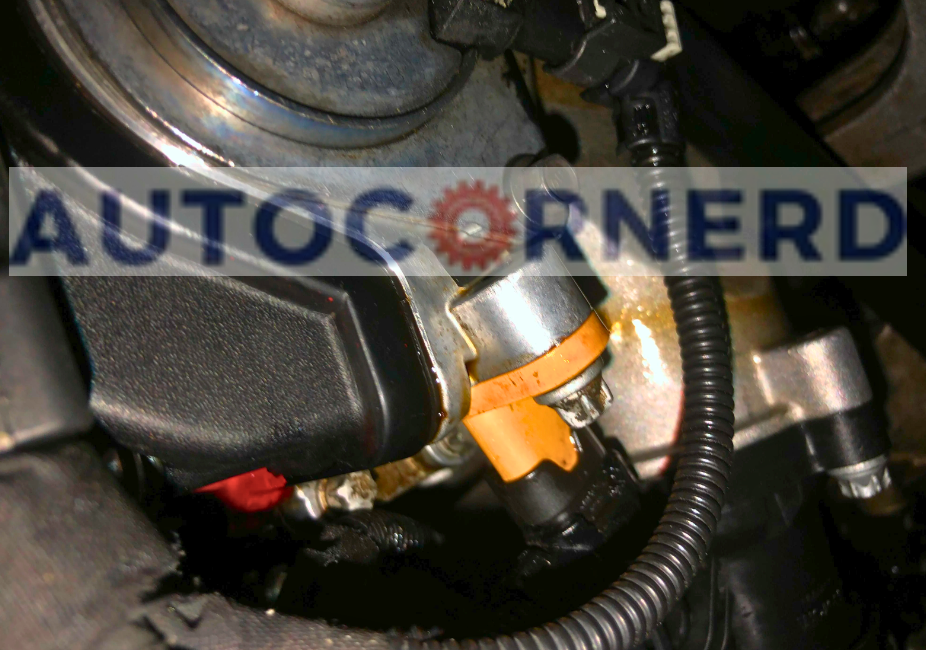
Camshaft and crankshaft sensors are responsible for monitoring the position of the crankshaft and camshaft and are responsible for the proper functioning of the engine. They are located in the engine, and when the engine is running, the sensors send signals to the ECU.
Also Read: What happens when cam phasers go bad due to low engine oil
The crankshaft and camshaft position sensors are both sealed with rubber O-rings. These O-rings keep oil from leaking out of the engine. Over time, these O-rings can become brittle and dry out, which can cause them to crack or break. When this happens, the oil that is inside the engine can start to leak out, resulting in an oil leak.
The camshaft sensor is located near the top of the engine i.e. close to the camshafts. Usually, you’ll find a camshaft sensor around the valve cover.
As I explained above, the oil flows over the camshafts to lubricate them. If the seal of the camshaft sensor is damaged, the oil will leak through the engine.
Similarly, the crankshaft position sensor is located closer to the crankcase (bottom part) of the engine. A crankcase is a part of the engine block where the crankshaft is located. Engine oil flows through the crankcase to lubricate the crankshaft.
Somewhere around the crankcase, the crankshaft sensor is located. If the o-ring of the crankshaft sensor is damaged, the oil will leak through the crankcase.
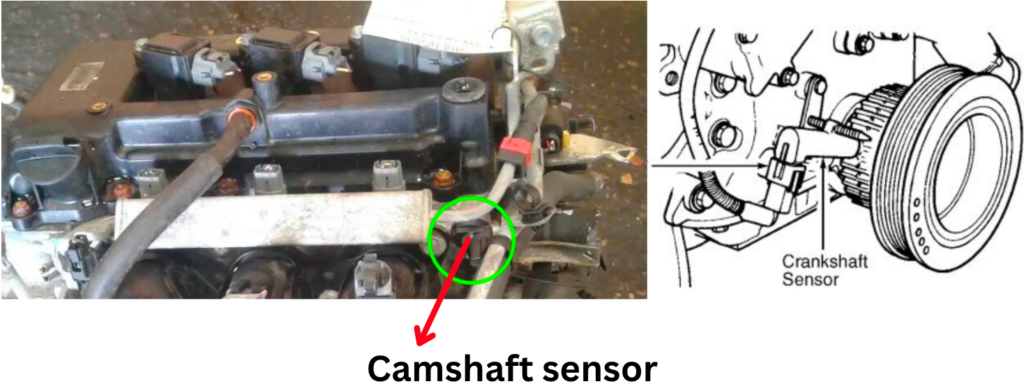
7. Damaged Rear Main Seal
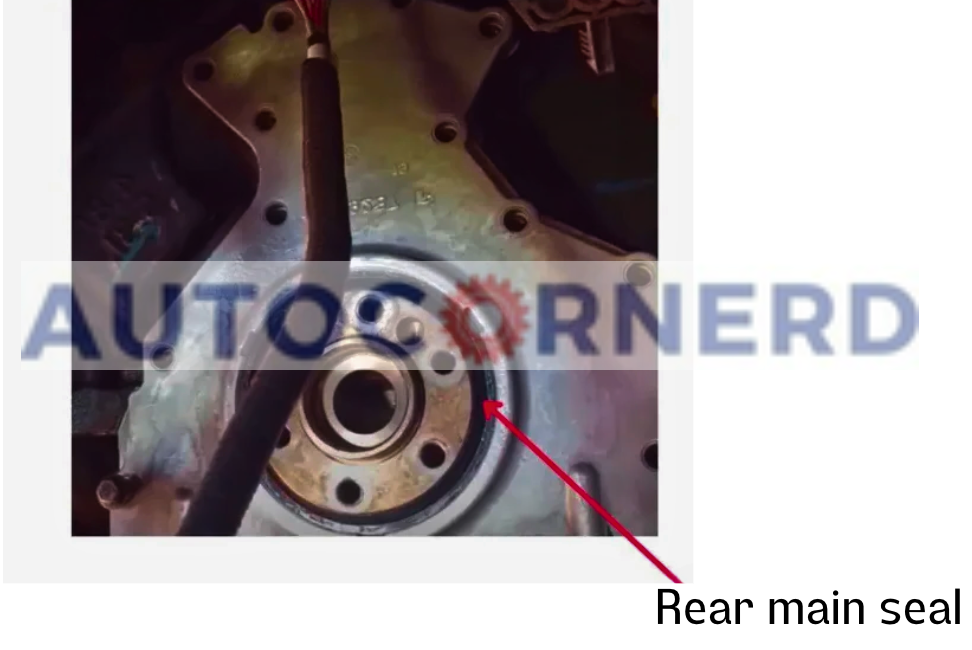
The rear main seal is an important part between the engine and transmission. It keeps engine oil from leaking out.
Oil collects at the bottom of the engine near the rear main seal. If the rear main seal cracks, oil can leak through.
You may see oil dripping from the flywheel or bell housing. That likely means the rear main seal is damaged.
The rear main seal is made of rubber. Over time, it can wear out, get brittle, or crack from heat. Debris in the oil can also damage it.
8. PCV System Is Not Working Properly
The Positive Crankcase Ventilation system (PCV) is a critical part of your engine’s emission control system.
It helps keep the pressure inside the engine at a safe level by removing the oil vapors that build up pressure in the crankcase.
PCV system works by sucking out the oil vapors through a hose via a PCV valve and sending them back through the intake manifold.
The PCV valve:
- Closes slightly to reduce airflow at low RPM (idle), when the vacuum is high.
- Opens more to increase airflow at high RPM, when the vacuum is low.
If PCV valve is stuck closed, the pressure of oil vapors will build up in the crankcase which will cause oil to leak from the engine seals under high pressure.
How to spot bad PCV valve?
To test if the PCV valve is stuck closed, you can remove the oil filler cap and place the paper on its opening. If it does not hold the paper against its opening, it means there is no vacuum and the PCV valve is malfunctioning.
Why Oil Only Leaks When Car Is Parked?
The main reason oil can only leak when your car is parked is the gaskets and seals. When the engine runs, the gaskets and seals heat up and expand. This makes a tight seal to keep the oil inside.
But when you turn off the engine and park the car, the gaskets and seals cool down and shrink. This can make them stiff and crack easier. Cracks let the oil leak out.
Another thing is the engine gets old. Over time, the seals and gaskets get worn out and stiff. This makes them leak easier too.
If you see oil leaks only when the car is not moving, you may need new seals and gaskets. This can stop more leaks.
When the engine runs, oil pumps through it. The pump keeps the oil moving and pressurized. This lubricates all the parts.
When you turn off the engine and park, the oil stops pumping. It can pool in places. The pooled oil can then leak out.
Also, after 100,000 miles, use slightly thicker oil. For instance, if you have been using 5w20 before, you can 5w30 oil instead of 5w20.
As the engine gets old, its parts wear out. The gaps between parts get bigger. Thinner oil can leak through the gaps. So use thicker oil in older engines. You can read my guide on the best oil for cars with over 200000 miles to learn more.
How To Spot The Cause Of Oil Leakage From The Car?
If oil is leaking from the car when parked uphill, you should bring the vehicle onto flat ground, and jack it up. Then place a piece of cardboard underneath the vehicle for a day, and see where the oil is.
To identify oil leak spots on your car, you must clean it all up with an engine degreaser and check it a few times once it’s clean.
This is because oil leaks can start higher up and dribble down, making it look like it is leaking from somewhere else. The wind current from driving can also push oil far from its point of origin.
So, after a thorough cleaning, you can spray talcum powder all over. The source will appear as a brown spot in the white talcum powder.
You can also add ultraviolet dye to the oil, run the engine with it and look for the leak with a UV light.
Final Thoughts
In summary, oil leaks can seem very confusing when a car is parked. But with some careful troubleshooting, the source can be found.
Regular checks and maintenance of seals, gaskets, sensors, and the PCV system are important to stop leaks. If a leak happens, cleaning the engine very well and using things like talcum powder or UV dye can show where it is coming from.
As a car gets older, thicker oil may help reduce leaking. Catching leaks early and fixing the problem quickly lowers the chance of big engine damage.
Oil Leaks When Car Is Parked: FAQs
How much does it cost to fix an oil leak?
The cost of fixing an oil leak can range from relatively affordable to quite costly, depending on the severity of the leak and the type of car you own.
If it’s a minor leak like changing the drain plug or gasket of the oil pan, you may be able to repair it yourself.
If you’re lucky, and the oil leak is caused by a oil filter that needs to be replaced, the repair is likely to be much less expensive.
However, if it’s a major leak like a valve cover gasket, it’s best to consult a professional automotive technician.
Is an oil leak serious?
A major oil leak can cause your oil level to drop faster than normal. This can lead to other issues with your vehicle, such as a worn timing chain, camshafts, or even piston and cylinder issues. In some cases, a major oil leak can cause your engine to seize up.
What is the cause of oil leaks when a car is parked?
Oil leaks when a car is parked can be caused by a variety of issues, such as a faulty oil filter, worn-out gaskets, or a cracked oil pan.
How do I know if my car is leaking oil?
You can tell if your car is leaking oil by visually inspecting the area around the engine for any signs of oil. You can also look for puddles of oil when parking or driving your car and check the oil level on the dipstick.
Some First Hand Experiences Shared By Users In Different Communities
Our team conducted research across various online communities, forums, and subreddits to gather user comments and opinions on “oil leaks from car at rest”.
User 1 says:
My 2017 Chevrolet Malibu had an oil leak that I discovered through a small puddle under the car. It was a faulty rear main seal. A bit expensive to fix, but it solved the problem.
User 2 says:
Had a bit of a scare with my Subaru Impreza when I noticed oil leaking. It was due to a damaged head gasket, evidenced by white smoke and oil under the car. Repaired it, and it’s been running well since.
User 3 says:
Experienced an oil leak in my Nissan Sentra. The issue was with the oil drain plug. It wasn’t tightened properly during the last service. I spotted the problem from oil spots on my driveway. A quick fix, and it was sorted.
User 4 says:
Had an oil leak in my Lexus ES. The issue was a bit tricky – it was the camshaft sensor seal that was leaking. Found out after seeing oil traces on the engine. Got it repaired, and the car’s been great since.
User 5 says:
Recently found an oil leak in my 2016 Honda Accord. Noticed some oil spots on the driveway. After inspecting, I realized it was the oil pan gasket that had worn out. Replaced it at a local mechanic, and it’s been fine since.
